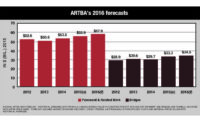The construction industry next year will continue its slow climb out of a long and deep recession, but the recovery is unsteady and remains vulnerable to factors such as the cloudy federal fiscal picture, according to McGraw-Hill Construction’s 2013 forecast, which was released at its annual Outlook conference in Washington, D.C., on Oct. 24.
Total construction starts will rise 6% next year to $483.7 billion, as a continuing rebound in housing and private nonresidential building outweighs weakness in institutional building and public works markets, says the unit's forecast. ENR is part of McGraw-Hill Construction (MHC).
That gain would follow an estimated 5% increase for 2012, but it still would be well below 2007’s $641-billion and 2008’s $559-billion totals.
Robert Murray, MHC chief economist, says, “The pattern of construction starts seems to be in a balancing act, where gains for a few project types are offset by declines for other project types.”
Murray also says, “The fiscal cliff poses a significant downside risk to the near-term prospects for the U.S. economy and the construction industry.”
For his forecast, Murray assumes that federal policymakers will avoid a plunge over that fiscal cliff. He expects that Congress and the White House will reach an agreement in early 2013 to maintain some of the Bush-era tax cuts now slated to expire on Dec. 31 and also to soften the impact of spending cuts set to take effect Jan. 2 under the 2011 Budget Control Act.
Underpinning MHC’s 2013 forecast is the growing strength of the housing market, which finally turned the corner in 2012 after years of depressed activity.
Single-family housing is expected to increase 24% in 2013 to $153.1 billion, following this year’s 27% gain, according to the forecast. “The positives for single-family housing have become more numerous with the pace of foreclosures easing, home prices stabilizing and mortgage rates at record lows,” says Murray.
In addition, multifamily housing starts are expected to climb 16% next year, to $40.3 billion, Murray also predicts.



Post a comment to this article
Report Abusive Comment